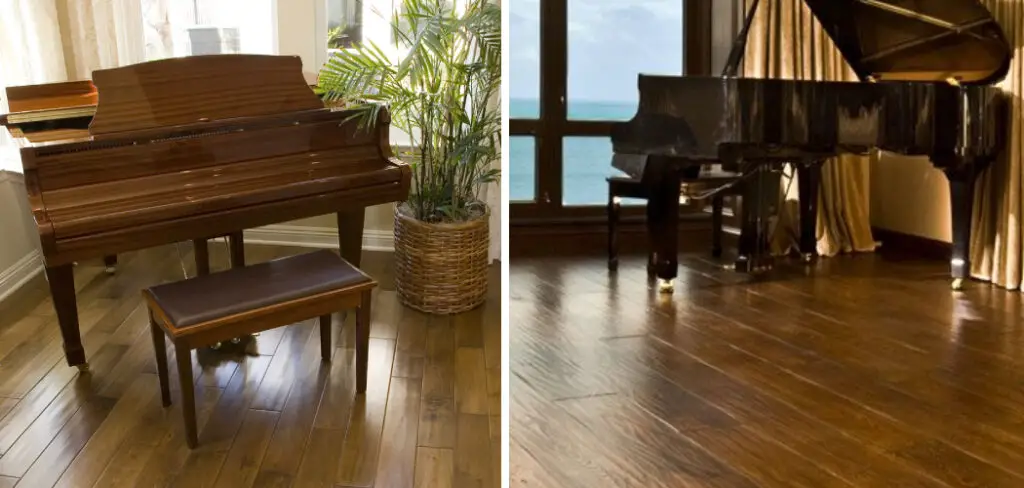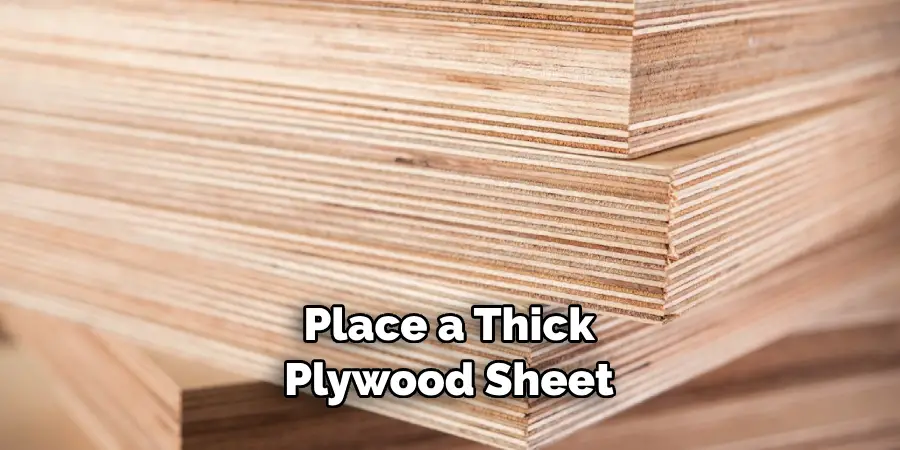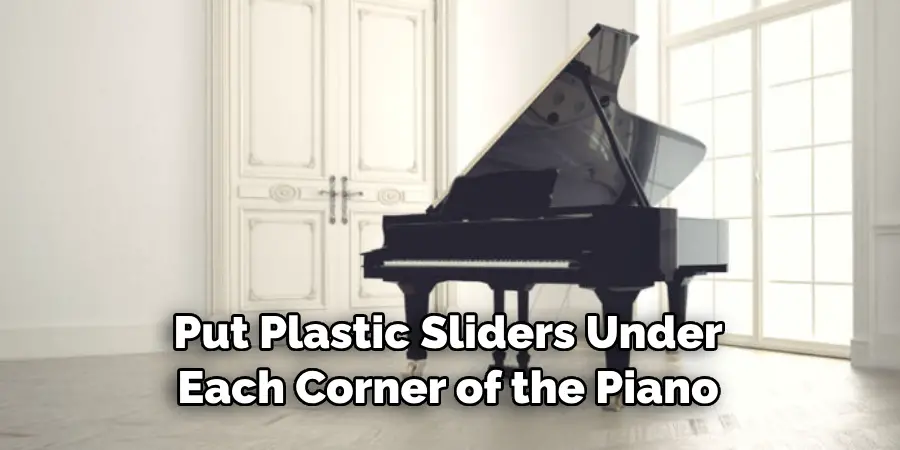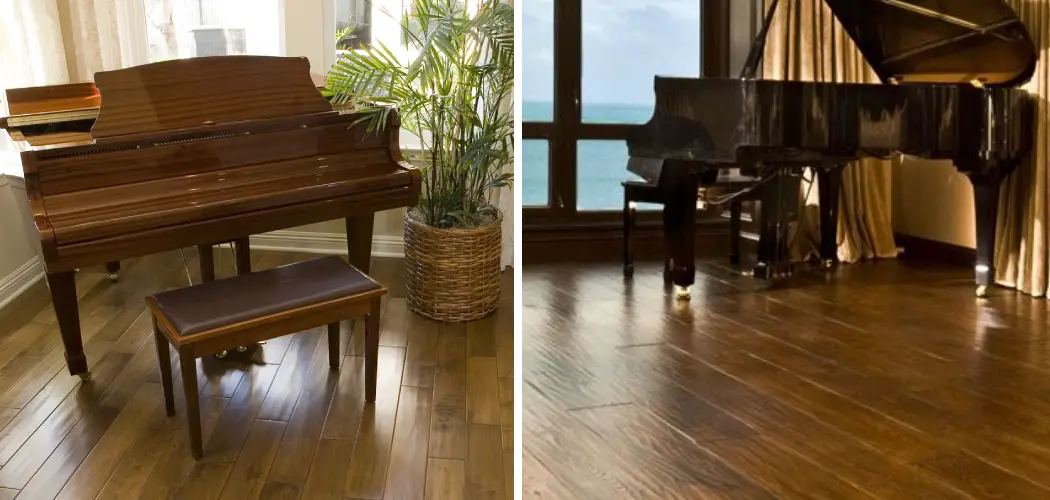When moving a piano, it is important to take all necessary precautions to ensure the floor and walls are not damaged. Moving a piano can cause scratches and dents in hardwood floors or even tear up carpets if not done carefully. This can be an expensive repair, so it is best to learn how to move a piano without scratching the floor.

Moving your piano without scratching the floor can save you money and hassle. If you scratch or damage your floors, you may have to pay for costly repairs or even replacement, depending on the type of flooring. Moving a piano without damaging your floors also helps maintain its value if you ever sell it. In this blog post, You will learn in detail how to move piano without scratching floor.
Step-by-Step Processes for How to Move Piano Without Scratching Floor
Step 1: Inspect the Floor
Before moving the piano, check to see if there are any scratches or dents on the floor. If there are, use a filler pencil or wood putty to fill them in. Ensure your piano is securely covered with a protective cover, and secure it with straps. Remove all items from around the piano, such as furniture and decorations.
Step 2: Make Sure the Piano is Securely Supported
Use a furniture dolly and secure it through the wheels. Ensure the piano is tightly secured, as slippage can cause damage to your flooring. Place a wide rug underneath the piano dolly to help cushion its weight on your floor. Move slowly and carefully, as sudden jerks can cause damage to your floors.
Step 3: Use Caster Blocks
Attach caster blocks to the legs of your piano for additional support. This will help prevent scratches on your floor due to dragging or sliding across the surface. Place a thick plywood sheet or rubber mat between the piano and the floor to protect both the surface of your floor and the piano.

Step 4: Lift with Care
When lifting the piano, use appropriate lifting techniques to avoid back injury. If you cannot lift it alone, enlist help from a friend or professional moving company. Once you’ve successfully situated your piano, be sure to level it by adjusting the feet of the instrument. This will help keep your floor scratch-free and ensure that your piano sounds its best.
Step 5: Remove Caster Blocks and Protective Coverings
After placing your piano in its new home, remove the caster blocks and any protective coverings you’ve used. You’ve now completed safely moving your piano without scratching your floors! Now all that is left to do is sit back and enjoy the beautiful music your instrument will make.
By following these steps, you can protect your flooring and piano when moving it around the house. Whether you’re a professional or an amateur musician, these tips will help you keep your floors safe from harm.
Tips for How to Move Piano Without Scratching Floor

- Ensure you have the necessary tools and equipment for moving a piano, including two or more people, furniture dolly, blankets and wraps, straps, and plastic sliders.
- Create a clear path from where you’re starting to where you’ll be finishing with no obstacles.
- Make sure to wrap your piano with blankets and furniture wraps and secure them with straps or rope so it doesn’t move around during transport.
- Put plastic sliders under each corner of the piano before moving it, as this will help reduce friction and minimize any potential scratches on the floor.
- Don’t try to lift or move your piano alone; two or more people are required for a successful move.
- Moving a piano requires patience and precision; take your time and go slow as you navigate through tight spaces and around corners.
- When transporting your piano to its destination, make sure to place down blankets or furniture slides on the floor so that when you set it down, there will be no scratching of the surface below.
Following these simple steps, you can move your piano without scratching any floors.
What Are the Steps Involved in Moving a Piano?
Moving a piano without scratching the floor requires careful planning and execution. Here are the steps involved in moving a piano safely:
- Plan Ahead: Before attempting to move the piano, consider factors such as your available space and any obstacles or tight corners that may need to be navigated. Also, ensure that all necessary items for the move are present and everyone involved is well-versed in what must be done.
- Find the Right People: Moving a piano requires at least two people, depending on weight and size. Make sure those helping have appropriate experience with moving large items like pianos.
- Prepare the Piano: Remove any objects from the top and secure all the keys, pedals, and other parts. Put a blanket or packing quilt over the entire piano to ensure no damage occurs during transit.
- Prepare the Floor: Place moving blankets or cardboard on the floor where you plan to move the piano to protect it from scratches.
- Lift Carefully: Make sure the piano is balanced before lifting, and everyone uses good lifting techniques.
- Move Slowly: Move the piano slowly and carefully, ensuring no sharp turns or sudden stops are taken. Take frequent breaks if needed to reduce the risk of injury.
- Secure the Piano: Once you have reached your destination, ensure the piano is properly secured so it won’t move or shift during transport.

Following these steps will help ensure your piano’s safe and successful move without risking any damage to the floor.
What Kind of Furniture Should I Use to Enable the Safe Piano Moving?
When moving a piano, the best way to ensure you don’t scratch the floor is by using furniture-moving equipment. Furniture sliders and dollies are two of the most popular tools used for this purpose. The sliders provide extra protection by creating an even layer between the piano and the floor. At the same time, dollies can help distribute the piano’s weight and make it easier to move.
Before attempting any moving job, make sure that you have all of the necessary furniture-moving equipment on hand, including sliders, dollies, straps or rope for securing the piano in place, blankets for padding or extra protection between the piano and floor, and protective covering for your hands and arms. Consider investing in additional protective materials, such as non-skid pads for the floor and anti-scratch tape for the legs of the piano.
What is the Best Way to Ensure That a Piano Won’t Scratch Floors While Being Moved?
Moving a piano without scratching floors is possible, but it requires careful preparation and the right tools. Before beginning, ensure you have enough people to help with lifting, carrying, and setting down the piano. First, cover any hard floor surfaces with layers of blankets or sheets. Ensure all areas around where the piano will be moved are covered. Also, consider using strap-on felt pads on the legs of the piano to reduce friction further when sliding the instrument.
If you are transporting a grand piano, removing the lid and covering up any exposed parts will be necessary before moving. Use a two-wheeled dolly with locking swivel wheels or skids for upright pianos. Maneuvering a grand piano is especially tricky, so hiring professional movers versed in this activity may be best. When lifting the piano, never lift it by the legs, as this can cause permanent damage. Use two or more moving blankets and secure them under the instrument with tape. Lifting should only be done by several strong people using the proper technique and done slowly and steadily.
How Can You Avoid Any Potential Hazards Associated With Moving a Heavy Piano?
You must take extra precautions when moving a piano to ensure it doesn’t slip or scratch your floors. Here are some tips to keep in mind when attempting to move a piano without damaging your floor:
- Use the Right Equipment: You’ll need a sturdy dolly with large enough wheels to support the instrument’s weight and thick, heavy-duty blankets for padding. You’ll also need thick cardboard or plywood to protect the floor from any potential scratches and a couple of friends to help carry the instrument.
- Prepare the Piano: Before moving your piano, ensure everything inside is securely fastened, and all casters are properly secured. If possible, take off the legs of the piano to reduce its weight.
- Lift With Care: When lifting and carrying your piano, always bend with your knees and lift using your leg muscles rather than your back. Never twist or jerk the instrument, as this can cause serious damage if not done properly.
- Place Padding on the Floor: Before placing the piano onto its new home, ensure you have placed thick blankets and cardboard underneath the instrument. This will help protect your floor from any scratches or damage.
- Secure the Piano: Once you finally reach its destination, secure all the legs and casters so that it stays firmly in place while being played.

Following these tips, you can avoid any potential hazards of moving a heavy piano and ensure your floors remain unscathed.
Conclusion
In conclusion, moving a piano without scratching the floor requires patience, skill, and proper preparation. First, it is important to understand the size and weight of your piano to ensure that you have enough people available for assistance. You should also use protective equipment such as blankets, skids, sliders, and dollies to protect your flooring and your piano. Finally, practicing safely lifting and maneuvering the instrument before attempting to lift and move it on your own is a good idea. Reading this post has helped you learn how to move piano without scratching floor. Make sure the safety precautions are carried out in the order listed.
About
Angela is the chief editor of Indoorense. She began her career as an interior designer before applying her strategic and creative passion to lifestyle and home.
She has close to 15 years of experience in creative writing and online content strategy for housekeeping and cleaning,home decorations as well as other efforts.
She loves her job and has the privilege of working with an extraordinary team. She lives with her husband, two sons, and daughter in Petersburg. When she’s not busy working she spent time with her family.

